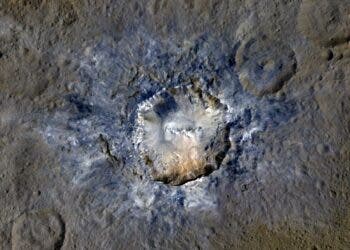At first glance, Ceres looks like one of the least likely places to harbor life. The dwarf planet, sitting quietly in the asteroid belt between Mars and Jupiter, is now a cold, nearly airless, grey world covered with ice and salt. However, a new study suggests that this appearance can be deceiving.
In fact, in its geological past, Ceres may have been surprisingly Earth-like in some regards.

According to the study authors, billions of years ago, Ceres may have had the three most important ingredients for habitability: water, organic molecules, and a long-lasting source of chemical energy. This hidden energy supply, the study authors argue, may have even enabled simple microbes to survive deep underground.
The study doesn’t claim that Ceres definitely hosted life; there’s no evidence to support that. However, it does suggest this dwarf planet was geologically active and habitable at some point in time. But even if Ceres had life billions of years ago, why does it matter now?
Joe O’Rourke, one of the study authors and a professor at Arizona State University’s School of Earth and Space Exploration, answered the question by putting things into perspective; it’s not just about Ceres.
“If Ceres was habitable in the past, then probably there are tens of asteroids and moons that were also habitable in the past. And if you can keep them hot, maybe [they are] still habitable today.”
Exploring the Possibility of Life on Ceres
NASA’s Dawn spacecraft, which orbited Ceres between 2015 and 2018, previously revealed some surprises about this frozen cosmic wonder. For instance, the bright reflective patches on Ceres’ surface turned out to be salt deposits, left behind by salty water that bubbled up from underground.

Further research in 2020 confirmed that these briny outflows were linked to a vast underground reservoir that is 40 km deep and hundreds of miles wide. Moreover, Dawn detected carbon-based organic molecules on the dwarf planet, an essential building block of life. Due to these findings, scientists already knew that Ceres had water and carbon.
However, what was missing from the puzzle was an energy source, something life could eat. That’s where this new study comes in. The study authors created computer models to track how Ceres’ interior evolved over time. They focused on a key period between 2.5 and 4 billion years ago, when the dwarf planet’s rocky core would have been at its hottest.
Back then, radioactive elements inside the core were decaying and releasing heat. That heat could have powered hydrothermal activity — hot water circulating through rocks, dissolving gases and minerals along the way. The models showed that these mineral-rich fluids may have seeped into Ceres’ underground ocean.
Surprisingly, similar processes are also seen on our planet at hydrothermal vents on the ocean floor. Despite the lack of sunlight, microbial life thrives in these environments, extracting energy directly from the chemical soup. The researchers suggest that something similar could have happened on ancient Ceres.
“On Earth, when hot water from deep underground mixes with the ocean, the result is often a buffet for microbes — a feast of chemical energy. So it could have big implications if we could determine whether Ceres’ ocean had an influx of hydrothermal fluid in the past,” Sam Courville, lead study author and a researcher at the University of Arizona, said.
In simple terms, Ceres had a kitchen with all the right ingredients: water to host life, organic molecules to build it, and hydrothermal energy to feed it. The catch is that this kitchen was likely active only during a limited window of time, a half to two billion years after Ceres first formed.
So, Were There Many Habitable Planets Around?
Today, the dwarf planet’s interior is too cold, with surface temperatures varying between -33 °C to -143 °C, leaving no room for life. Its radioactive heat source has mostly burned out. What little liquid water remains is now a concentrated brine locked under thick ice.
However, if Ceres was ever habitable like the study suggests, then it means many other icy worlds, moons, and dwarf planets of similar size may also have gone through their own warm and wet phases in the distant past. If so, then habitability may be far more common across the solar system than we once thought.
There is also one big limitation of the study. The current models are based on limited data, and to confirm the findings, scientists would need a closer look at Ceres’ surface chemistry, ideally by sending a lander or even a sample-return mission.
For now, the results provide a new way of thinking about worlds that appear frozen and dead today.
The study is published in the journal Science Advances.
![{"shape": [8200, 8200, 3]}](https://cdn.zmescience.com/wp-content/uploads/2025/01/Euclid_s_view_of_spiral_galaxy_IC_342_pillars-350x250.jpg)





